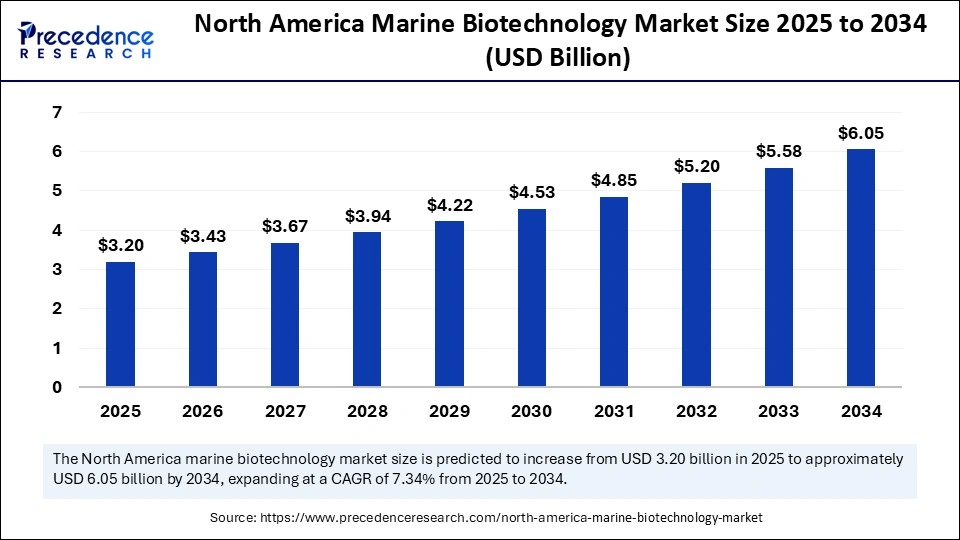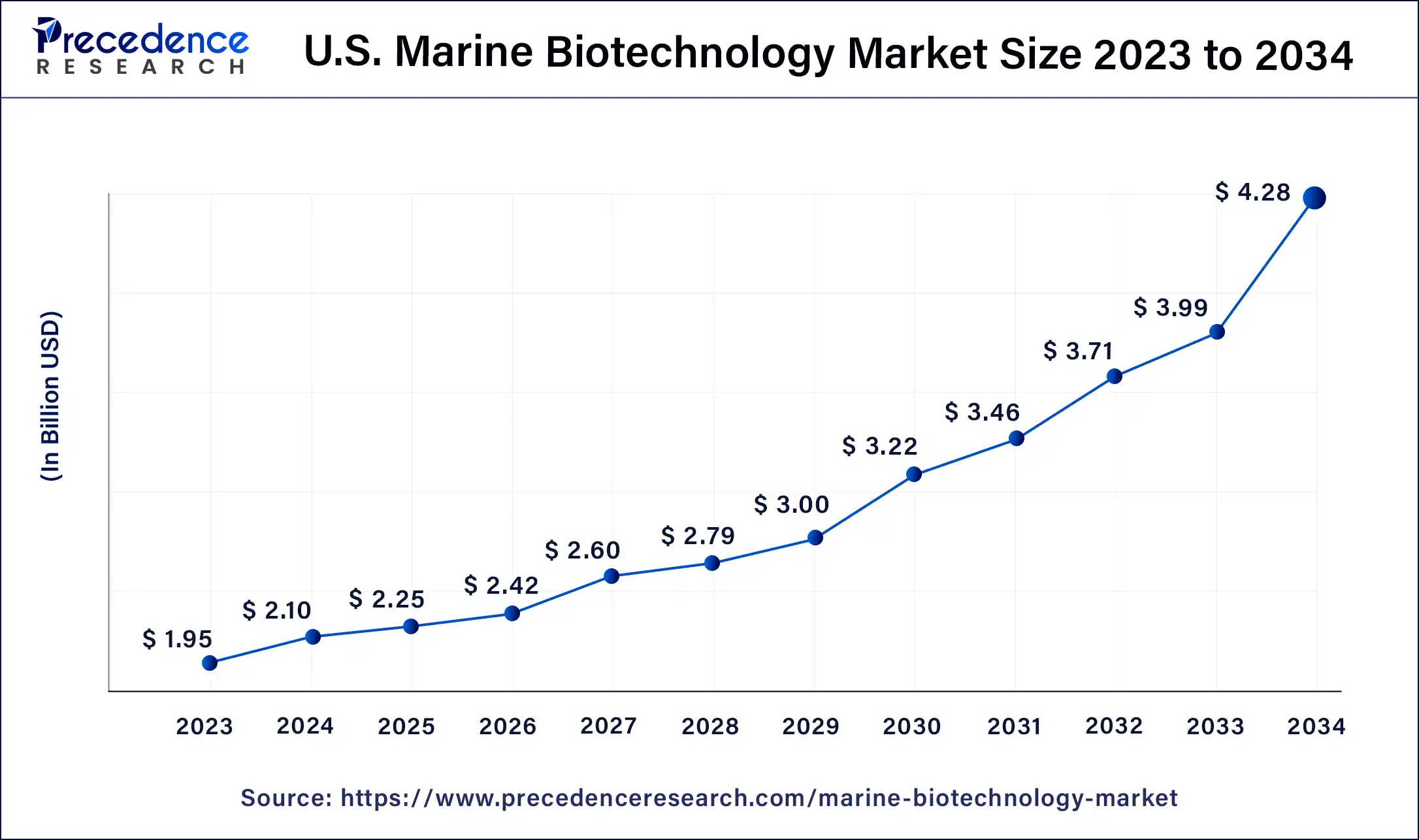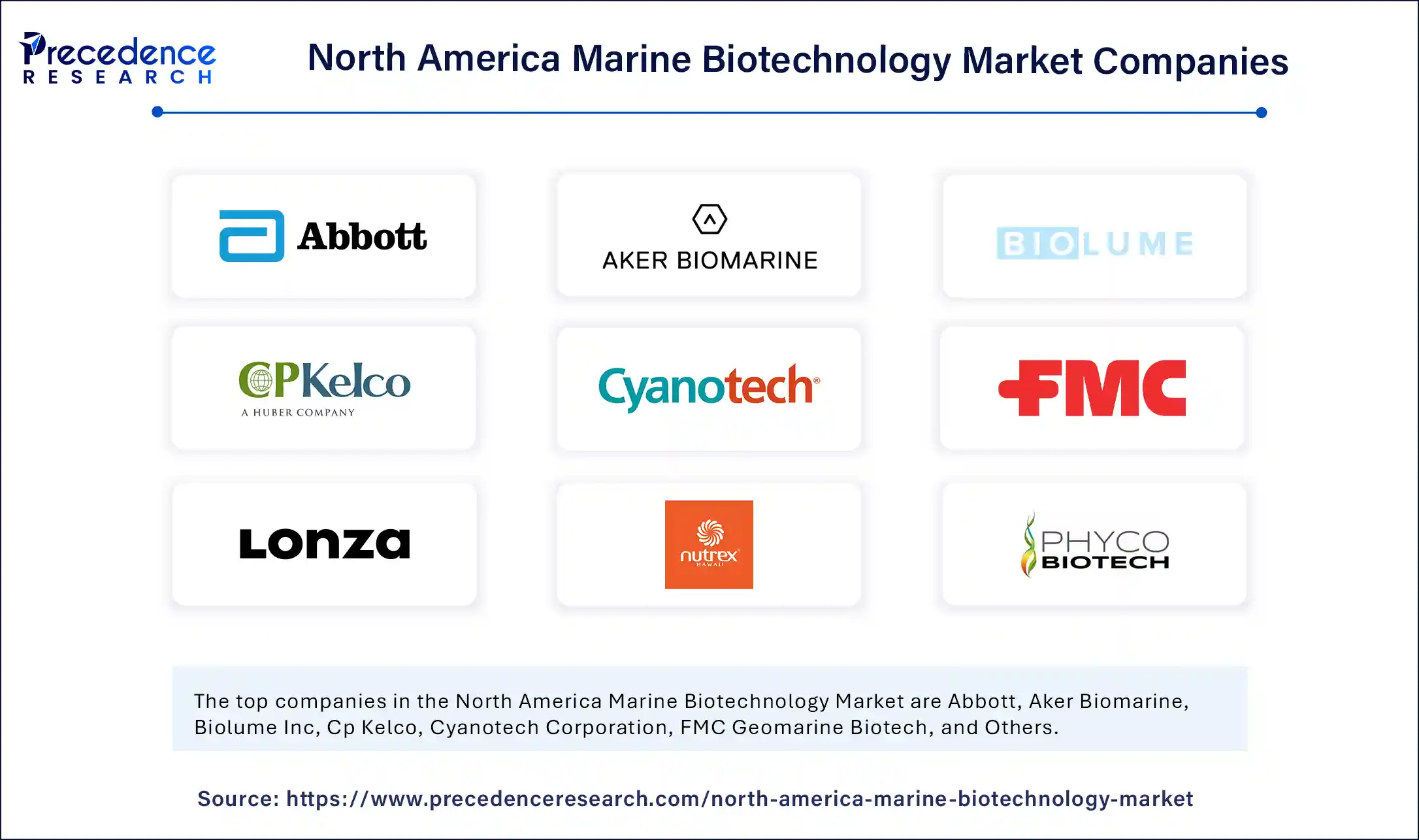List of Contents
North America Marine Biotechnology Market Size and Forecast 2025 to 2034
The north america marine biotechnology market size accounted for USD 2.98 billion in 2024 and is predicted to increase from USD 3.20 billion in 2025 to approximately USD 6.05 billion by 2034, expanding at a CAGR of 7.34% from 2025 to 2034. The market growth is attributed to increasing investments in sustainable marine-derived products for pharmaceuticals, nutraceuticals, and industrial applications across North America.

North America Marine Biotechnology MarketKey Takeaways
- In terms of revenue, the North America marine biotechnology market was valued at USD 2.98 billion in 2024.
- It is projected to reach USD 6.05 billion by 2034.
- The market is expected to grow at a CAGR of 7.34% from 2025 to 2034.
- By source, the algae segment held the major market share in 2024.
- By source, the corals and sponges segment is projected to grow at a CAGR in between 2025 and 2034.
- By application, the medicine segment contributed the biggest market share in 2024.
- By application, the aquaculture and fishery segment is expanding at a significant CAGR between 2025 and 2034.
- By end user, medical and pharmaceutical captured the highest market share in 2024.
- By end user, food industry companies segment is expected to grow at a notable CAGR from 2025 to 2034.
What is the Role of AI in Marine Biotechnology?
The area where artificial intelligenceis notably changing the marine biotechnology industry in North America is through improving research accuracy, speeding up discovery activities, and making much better resource utilization. Organisations and research facilities use AI-powered models to examine intricate marine environments and isolate bioactive chemicals of marine life. Moreover, the AI is also facilitating more use of advanced monitoring systems of tracking on how healthy the ocean fares to allow real-time data collection and predictive analysis toward the management of marine resources.
Market Overview
The North America marine biotechnology market is likely to expand courtesy of the increasing demand of sustainable bioactive compounds. The marine biotechnology uses the exploration and utilisation of marine organisms, to develop products in pharmaceuticals, nutraceuticals, cosmetics and industrial procedures. It is an area that employs more of the tools of molecular biology, genomics, and bioprocessing to extract and analyze substances that answer the health, energy, and environmental problems. United States has one of the largest Exclusive Economic Zones (EEZs), according to the National Oceanic and Atmospheric Administration (NOAA) has biodiversity that covers more than 3.4 million square nautical miles, and it is abundant in research and commercial uses.
In 2024, the Ocean Exploration Program of NOAA prospecting efforts in the deep sea, grabbed new samples of microbial and invertebrates along the margins of the Atlantic and Pacific. Furthermore, the growing interest for marine-based industrial enzymes, biomaterials, and aquafeed solutions in this region also contributes to the market growth.
U.S. Marine Biotechnology Market Size and Growth 2025 to 2034
The U.S. marine biotechnology market size was exhibited at USD 2.1 billion in 2024 and is projected to be worth around USD 4.28 billion by 2034, growing at a CAGR of 7.38% from 2025 to 2034.

North America Marine Biotechnology MarketGrowth Factors
- Rising Demand for Marine-Based Cosmeceuticals: Growing consumer preference for clean-label, anti-aging skincare is fuelling the use of marine bioactives in premium cosmetic formulations.
- Boosting Blue Economy Initiatives: National efforts to develop sustainable ocean-based industries are driving public-private investments in North America marine biotechnology infrastructure and research.
- Growing Applications in Industrial Biocatalysis: Increasing use of marine-derived enzymes for eco-friendly industrial processes is propelling innovation in green manufacturing technologies.
- Expanding Marine Genomic Databases: Advances in marine genetic sequencing, led by institutions such as USGS and NOAA, are accelerating the discovery of commercially viable marine biomolecules.
- Driving Personalized Nutrition Trends: Rising adoption of marine nutraceuticals tailored to individual health profiles is boosting demand for algae-based functional food components.
- Surging Interest in Marine-Derived Antimicrobials: Escalating antibiotic resistance is driving research into novel antimicrobial compounds from sponges and marine bacteria.
- Advancing Marine Waste Valorization Technologies: Development of biorefinery techniques that convert marine biomass into high-value products is supporting circular economy goals and fuelling market expansion.
Market Scope
| Report Coverage | Details |
| Market Size by 2034 | USD 6.05 Billion |
| Market Size in 2025 | USD 3.20 Billion |
| Market Size in 2024 | USD 2.98 Billion |
| Market Growth Rate from 2025 to 2034 | CAGR of 7.34% |
| Base Year | 2024 |
| Forecast Period | 2025 to 2034 |
| Segments Covered | Source, Application, End User |
Market Dynamics
Drivers
How Is Increasing Demand for Sustainable Marine-Derived Products Shaping the Marine Biotechnology Market in North America?
Increasing demand for sustainable marine-derived products is projected to drive market expansion. The growth in the market is envisioned to be on the rise in demand in marine-based products that are considered sustainable. The North American industries are on a sharp hunt to find natural replacements for synthetic compounds in pharmaceuticals, nutraceuticals, and cosmetics. Corporations are making investments in marine bioprospecting to find new enzymes, antibiotics, and biofuels, components that suit the environment and meet its regulations.
The transition to bioproducts based on the marine environment is aided further by the shift toward the models of circular economy in Canada and the United States. There are NOAA reports of an intense rise in the number of federally funded marine biotechnology ventures in the utilization of algal biomass and development of bioproducts in the U.S. coastal areas in 2024.Furthermore, the special exploratory funding programs were also initiated by the National Science Foundation in 2024 to focus on genomics and synthetic biology approaches to marine creatures is expected to fuel the market.
Restraint
Unpredictable Environmental Conditions Hamper Marine Resource Supply Chain Reliability
Unpredictable environmental factors are expected to hinder the market. These environmental factors that arise in the environment are likely to impact the consistency in the marine resource supply chain. The climate change, ocean acidification, and pollution endanger biodiversity and the stability of the marine ecosystem that expose the basis of biotechnology applications. The changes in temperature and salinity and the rise of harmful algal bloom interferes with algal cultivation and fishing in the U.S. and Canadian waters. Moreover, these changes have adverse effects on the feasibility of long-term bio-mass sourcing which affects commercial North America marine biotechnology sector growth in the coming years.
Opportunity
Why Are Growing Investments in Research Accelerating Innovation in the North America Marine Biotechnology Market?
Growing investments in marine biotechnology research is expected to create immense opportunities for the players competing in the market. High expenditures in the research of marine biotechnology improve innovation and commercialization. Funding, to which government authorities, such as NOAA, NSF, and Fisheries and Oceans Canada. They have contributed in the exploration of marine biodiversity, genomics, and bioprocessing technologies. The funding makes it possible for academic institutions and biotech companies to create scalable applications of marine organisms such as drug discovery, aquaculture feed to enhance, and biomaterials.
In 2024, several grants were given by the National Science Foundation (NSF), its Emerging Frontiers in Research and Innovation (EFRI) program, to do synthetic biology research with marine microbes and algae at California State, Massachusetts and Oregon universities. Additionally, the research facilities, including the Scripps Institution of Oceanography and Woods Hole Oceanographic Institution increased their marine biotechnology infrastructure in the year 2024 after getting funds both directly through the government and through industry partners further propelling the market.
Source Insights
Why Did the Algae Segment Dominate the North America Marine Biotechnology Market in 2024?
Algae segment dominated the North America marine biotechnology market in 2024, due to the the impressive versatility and high commercial potential of algae in many applications. Specifically, the algae (microalgae and macroalgae) have been cited as rich source of omega-3 fatty acids, antioxidants, proteins, pigments and polysaccharides in various nutraceuticals, pharmaceuticals, cosmetics, biofuels and functional foods.
More recently, in 2023 the NOAA indicated the Pacific Northwest and the Gulf of Mexico as priority marine areas of the sustainable cultivation of algae, expanding the sources of the internal resources. The Bioenergy Technologies Office (BETO) of the U.S. Department of Energy (DOE) increased its research activities in algal bioproducts supporting the development of large scale algae growth and downstream processing technologies.Out the excellent flexibility of algae to industrial bioprocessing and fast growth cycles making it the leader of marine biotechnology. Furthermore, the NSF funded a new multi-institutional program to support the sequencing of high-yield marine algal genomes, leading to fuelling the segment.
(Source: https://www.energy.gov)
The corals & sponges segment is expected to grow at the fastest rate during the forecast period, owing to the increasing demand of their rich bioactive compound content and the interesting secondary metabolites. Alkaloids, terpenes, polyketides, and other structurally varied molecules that are biosynthesized as a result of sponges and corals are structurally diverse. Most of these molecules are of strong anticancer, antiviral, and anti-inflammatory activity.
In 2024, NOAA Office of Ocean Exploration and Research by diving in deep seas with the aim to discover unclassified species of corals and sponges potential bioprospective future on the Pacific and Atlantic coast. Partnerships with marine science laboratories supported by NIH funding led to the development of preclinical compounds based on invertebrate organisms, primarily derived from coral and sponges, against cancer, neurodegenerative diseases and multidrug-resistant infections. Additionally, the US government funding programs to underpin the chemical signaling and isolation of compounds in deep water sponge communities is expected to boost the segment.
Application Insights
What Drove the Medicine Segment to Lead the North America Marine Biotechnology Market?
Medicine segment held the largest revenue share in the North America marine biotechnology market in 2024. Due to the increasing demand of new bioactive compounds that fit the gaps in treating diseases in the areas of oncology, infectious diseases, and chronic inflammation. The marine organisms, especially sponges, algae and deep-sea microbes are rich source of compounds of structural uniqueness exhibit promising pharmacological activity.Pharmaceutical enterprises with the assistance of National Institutes of Health (NIH) and National Science Foundation (NSF) were following through the development of new contacts with marine research hubs to speed up thedrug discovery programs. Furthermore, these trends are expected to enhance further the application of marine biotechnology in precision drug platforms and next-generation drugs.
- In January 2025, NOAA announced over US $1 million in funding for the Ruth D. Gates Coral Restoration Innovation Grants, promoting genetic resilience in coral species�this effort supports marine-derived pharmaceutical research by protecting biodiversity hotspots that serve as sources of novel drug compounds
(Source: https://www.fisheries.noaa.gov)
The aquaculture and fishery segment is expected to grow at highest CAGR during the forecast period, owing to the high demand of sustainable seafood production and effective control of fish health. The application of marine biotechnology allows creating such innovative tools as algae-based feed additives a disease-resistant fish strains and probiotic medicines. This further minimizes the application of antibiotics and help to increase the overall yield.
In 2024, Aquaculture biotech, the Sea Grant Program of the NOAA invested in a biotechnology study on the U.S. coastline in an attempt to increase success rates of hatcheries and larval survival rates by incorporating marine-based bioinputs. Moreover, the marine microbe products were useful in increasing the growth rates of farmed salmon, thus making the biotech-based aquaculture solutions more popular in North America.
(Source: https://seagrant.noaa.gov)
End User Insights
Why Did the Medical & Pharmaceutical Sector Hold the Largest Share in the North America Marine Biotechnology Market?
Medical & pharmaceuticals sector segment held the largest revenue share in the North America marine biotechnology market during the forecasting period, due to the growing interest of the clinics in bioactive substances of marine origins. Novel marine-based molecules entered the drug development pipeline considerably, because of their mechanisms of action that are new. National Institutes of Health (NIH) and the National Science Foundation (NSF) had increased the funds they allocated toward translational research into marine-based pharmaceuticals. The U.S. Food and Drug Administration (FDA) granted fast-track status to some candidates into marine-derived therapeutics.
- In October 2024, the U.S. Food and Drug Administration (FDA) granted Fast Track designation to Algexan, a marine algal compound for neurological inflammation, currently in Phase II trials by NeuroBlue Pharmaceuticals.
Deep-sea exploration introduction has also been done by NOAA that led to the discovery of new microbes with a possibility of being used pharmaceutically. The clinical effectiveness of marine peptides and alkaloids, a further strengthening of the trend of increased dependence of medicine on oceanic resources to address unmet medical needs. Furthermore, the joint efforts of U.S. research and industries made it easier to access marine biobanks, thus boosting the market.
The food business segment is expected to grow at significant CAGR in the upcoming period, owing to the increasing consumer curiosity regarding functional foods and also clean label ingredients with marine sources. The world of algae, seaweed, and marine protein concentrates in plant-based food substitutes, enriched snacks, and beverages as they respond to the need to fulfill the nutraceutical weight of food products in sustainable foods.
Food bio-tech companies and academic institutions in coastal states increased the R&D activity on flourishing improvements, protein enrichments and shelf life stabbing using the marine bi-actives. Additionally, the microalgae within the U.S. coastlines to stabilize scalable production of marine ingredients in the food industry, thus further fuelling their demand in this sector.
North America Marine Biotechnology Market Companies

- Abbott
- Aker Biomarine
- Biolume Inc
- Cp Kelco
- Cyanotech Corporation
- FMC Geomarine Biotech
- FMC Health And Nutrition
- Lonza Group Ltd.
- Nutrex Hawaii Incorporated
- Phyco Biotech Sas
- Qingdao Codo International Ltd
- Sea Run Holding
- Seppic Sa
Recent Developments
- In March 2025, the ANERIS project began integrating various marine life-sensing technologies to implement the concept of Operational Marine Biology. The ongoing biodiversity crisis threatens to eliminate or drastically alter much of the ocean's biodiversity before it is even identified. As climate and human-related pressures on marine ecosystems intensify, integrating biodiversity knowledge becomes crucial to monitor and evaluate these systems. Enhanced biological observation is urgently needed to understand long-term changes in marine ecosystems and biodiversity, especially in the face of growing global stressors and environmental shifts.
(Source:https://www.innovationnewsnetwork.com)
- In September 2024, the Dominican Republic introduced its first blue biotechnology company, SOS Biotech. This venture evolved from SOS Carbon, a Massachusetts Institute of Technology (MIT)-linked organization that developed the Coastal Collection Module (LCM) to remove sargassum at sea before it reaches shorelines. Under CEO Eng. Andr�s Bison� Le�n, SOS Biotech is focused on transforming marine challenges into sustainable global business solutions. The company produces industrial products from sargassum and other marine sources, tackling environmental concerns while simultaneously supporting economic advancement in coastal and island regions.
- In October 2024, Ittinsect rebranded to Ocean Twist Biotechnology to reflect its broader scope and cutting-edge biotech solutions. The company now produces high-performance protein concentrates using circular materials like insect meal and plant-based press cakes. Ocean Twist Biotechnology is developing these concentrates as sustainable alternatives to traditional ingredients such as fishmeal and soy in aquaculture and animal feed. CEO Alessandro Romano stated that the company addresses the fast-growing demand for fishmeal, noting that most novel proteins face barriers to wide-scale adoption due to limitations in nutritional compatibility and formulation stability.
Latest Announcements by Industry Leaders
- In May 2025, Innovasea, a provider of advanced aquatic technologies for fish tracking and aquaculture, has launched the Enhanced Aquaculture Technology for Marine Health Project, supported by Canada's Ocean Supercluster (OSC) and conducted in collaboration with Grieg Seafood Newfoundland. The initiative represents a projected investment of C$5.9 million (US$4.3 million). Grieg NL is contributing C$70,000 (USD 50,700) toward a trial deployment at its Red Island, N.L. facility, where Innovasea's aquaculture software, systems, and equipment will first be installed.
(Source: https://www.aquaculturenorthamerica.com)
Segments Covered in the Report
By Source
- Corals and sponges
- Algae
- Micro Algae
- Macro Algae
- Marine Viruses
- Marine Fungi
- Others
By Application
- Aquaculture & Fishery
- Medicine
- Environment
- Biofuels
- Other
By End User
- Medical & Pharmaceutical
- Food Industry
- Cosmetics Industry
- Chemical Industry
- Others
For inquiries regarding discounts, bulk purchases, or customization requests, please contact us at sales@precedenceresearch.com
Frequently Asked Questions
Ask For Sample
No cookie-cutter, only authentic analysis – take the 1st step to become a Precedence Research client